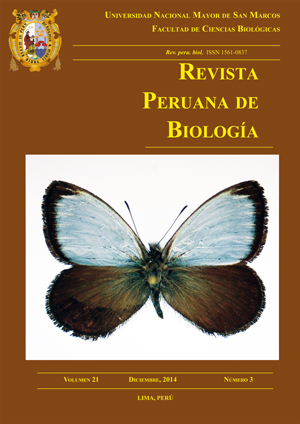Catch, effort and bycatch of longline fishery in central Peru
DOI:
https://doi.org/10.15381/rpb.v21i3.10898Keywords:
Mahi-mahi, blue shark, mako shark, longline, bycatch, CPUE.Abstract
The aims of this study is to report some characteristics of fishing trips, effort, catches, fishing areas and bycatch through observations on board and logbooks. 85% of sets were in the first 574 Km of distance from the coast (309 nautical miles). Farthest set was located at 1320 Km (712 nautical miles). A total of 382000 hooks were used to catch Mahi mahi, in 224 sets and 29 fishing trips, 94.6% of catch was Mahi mahi, 2.7% blue shark (Prionace glauca) y 1,3% mako shark (Isurus oxyrinchus). Also, 103790 hooks were used to catch sharks, in 109 sets y 12 trips, 81.9% of catch was blue sharks and 16.8% mako sharks. Catch per Unit of Effort (CPUE) for Mahi mahi shows significative difference among seasons; with a peak from November to January. CPUE for shark shows significative difference among seasons, with peaks in September and October. The Green turtle Chelonia mydas agassizii was the most caugth species and two of three were juveniles. All Loggerhead turtles, Caretta caretta, caught were juveniles. A petrel is reported as bycatch and, probably, mammal bycatch is scarce. Considering the huge effort of this fishery, it is important to monitor it and establish management actions.Downloads
Downloads
Published
Issue
Section
License
Copyright (c) 2014 Liliana Ayala, Raúl Sánchez-Scaglioni

This work is licensed under a Creative Commons Attribution-NonCommercial-ShareAlike 4.0 International License.
AUTHORS RETAIN THEIR RIGHTS:
a. Authors retain their trade mark rights and patent, and also on any process or procedure described in the article.
b. Authors retain their right to share, copy, distribute, perform and publicly communicate their article (eg, to place their article in an institutional repository or publish it in a book), with an acknowledgment of its initial publication in the Revista Peruana de Biologia.
c. Authors retain theirs right to make a subsequent publication of their work, to use the article or any part thereof (eg a compilation of his papers, lecture notes, thesis, or a book), always indicating its initial publication in the Revista Peruana de Biologia (the originator of the work, journal, volume, number and date).






